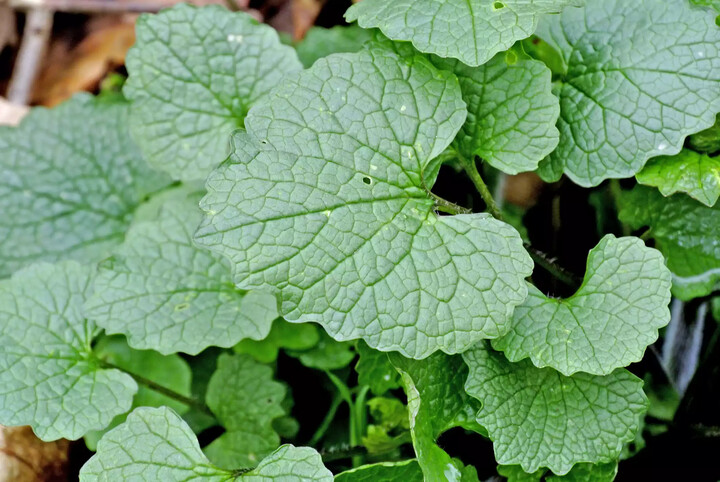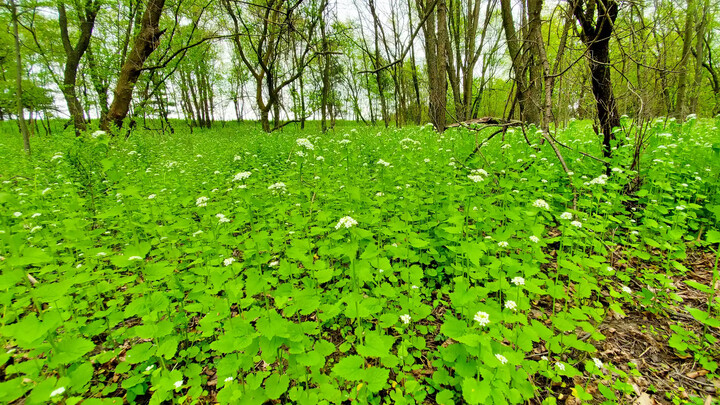The definition of a weed is not always clear-cut. Many naturalized plants, such as Queen Anne’s lace, are viewed as a nuisance by some and as a delightful flower by others. For garlic mustard, however, the conclusion is unanimous: It is a highly invasive plant that should be controlled by all means.
First introduced by European immigrants in the mid-19th century as a culinary and medicinal herb, garlic mustard quickly spread all across the United States, crowding out native plant species and in the process endangering insect diversity. At many locations in the United States garlic mustard has become such as problem that some County Noxious Weed Control Boards require property owners to eradicate it.
If you have garlic mustard in your yard, knowing the plant’s life cycle is important for effective garlic mustard control.
Invasiveness of Garlic Mustard
What makes garlic mustard so invasive is that a single plant produces between 600 and 7,500 seeds, and that the seeds can survive in the soil for up to five years.
What’s more, garlic mustard is also allelopathic, which means the plant releases chemicals into the soil that inhibit the growth of other plant species. If not controlled, garlic mustard will grow into the large monocultures, the types that you might have seen in wooded areas while hiking.
Garlic mustard also affects native insects including butterflies as it chokes out native host plants such trillium, hepatica, Dutchman's breeches, bloodroot, and wild ginger. These native plants serve native insects as egg-laying sites and food sources. The chemicals in the leaves of garlic mustard on the other hand kill the native butterflies that feed on them.
Gardening Considerations
Beneficial soil fungi that help tree roots absorb water and nutrients are affected by garlic mustard as well. Garlic mustard roots release chemicals into the soil that prevent these beneficial soil fungi from growing.
In its native habitats in Europe, garlic mustard has several native enemies that keep it under control. Since these natural checks and balances are lacking in North America—even deer won’t eat it—there is no natural control.
Botanical Name:
Alliaria petiolata
Common Name:
Garlic mustard, hedge garlic, sauce-alone, jack-by-the-hedge, poor man’s mustard, garlic root
Plant Type:
Biennial
Mature Size:
Three to five feet height
Bloom Time:
Spring
Flower Color:
White

Identification
Garlic mustard is a biennial. It propagates only by seeds and starts growing very early in the spring. In the first year, low-growing rosettes appear, which can be green or purplish in color. The leaves are kidney-shaped with scalloped edges. From these rosettes, eight-inch-long, thin, hairy stems will emerge. In the spring it is relatively easy to identify garlic mustard by the strong pungent garlic or onion smell of the new leaves, but that odor dissipates as the season progresses.
In the fall and winter, the rosettes remain green. Of the numerous first-year seedlings—up to 17,000 can fill one square yard—thankfully only a small fraction makes it through the winter.
In the second year, the surviving plants, between 25 and 375 per square yard, grow fast and produce one or more flowering stalks between one and four feet in height. One dead give-away of second-year garlic mustard is that in the early spring, there are no other tall, broad-leaf plants with white flowers.
After it blooms, the plant dies back but the seed stalks remain, scattering their evil load.
Where Garlic Mustard Is Found
While large swaths of garlic mustard are most frequently found in woodlands, it can grow virtually anywhere, in moist to dry soils, and in sunny to shady locations.
Areas of disturbed soil are a prime territory for garlic mustard. So, if you dig up an area of your yard and you’ve had issues with garlic mustard, don’t leave it unplanted, as garlic mustard will move in quickly.

How to Control and Remove Garlic Mustard
If garlic mustard pops up in your yard, you need to make sure that it does not turn into a satellite infestation. As soon as you spot them, remove the plants with their entire roots. If the soil is loose and wet, you might be able to hand-pull them but getting the entire taproot out usually requires a garden knife or similar weeding tool.
Remove second-year, mature garlic mustard with its entire roots before it starts to flower between April and June. If you miss that point in time, you will get another chance during the short time window when the garlic mustard is done flowering and before it sets seed within a few days.
Do not compost the pulled plants—the seeds can remain viable even in the hot temperatures of your compost bin or pile. Also, don’t leave the pulled plants lying around, as they may continue to develop and set seed.
Always dispose of the pulled plants in plastic bags and throw them in the garbage. You can also burn them, but you need to do it promptly before they dry because otherwise the seed pods can burst open and disperse the seed. First year-seedlings can also be buried deeply in a location that will remain undisturbed.
Applying herbicide is generally not recommended, as it will kill all other plants nearby, and even with repeated herbicide applications, the garlic mustard still comes back.
If you are dealing with a large, established infestation of garlic mustard, it will take several years to control it. By removing any emerging seedlings and mature plants before they spread more seeds, you can gradually exhaust the seed bank reserves.